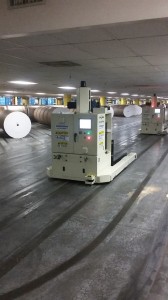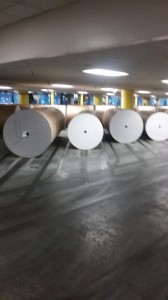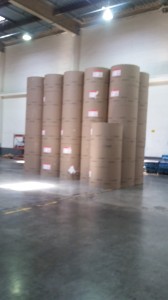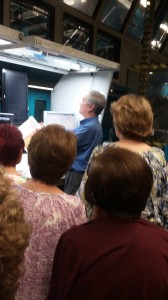THE LOS ANGELES TIMES ( PART 2 )
THE LOS ANGELES TIMES ( PART 2 )
By Charles N. Stevens
Photos by Dolores Seidman
After a 30 minute ride across town we arrive at the state of the art Los Angeles Times Printing Facility where the paper has been printed since 1989. Close to the intersection of Alameda and Olympic, it is a modern building, silver with large glass doors at its entrance.
As we enter a large foyer, we’re gazing through a large glass wall at the six great presses that print the paper. Technically they are called Goss Colorline Presses. Unfortunately, we are there at the wrong time to see them in action as they generally print at night so the paper will be ready for morning delivery. But just being able to see and contemplate the huge presses and the robotic machines that carry the great rolls of paper is quite a thrill. The “robots,” cream- colored, box like machines with a blinking amber light on top wait at the side of the room, ready for action. The floors, broad and smooth, are marked by the lines that guide the robots.
Our guide, the same gentleman that had talked to us at the Times Building, arrives to take us on a tour of the facilities. We first enter a large warehouse-like area where the rolls of paper are stored. The huge rolls are stacked on top of each other, some of them towering half a dozen high. It is like walking through a strange city surrounded by circular buildings. One of the tourists says, “This is like walking through a winery,” the stacked rolls resembling the storage vats of wine. We inhale the clean smell of paper rather than the sweet smell of wine.
The rolls of paper come from Canada, Washington and Oregon. Arriving at Los Angeles Harbor on ships, they are loaded on to box cars then transferred to the printing plant. The railroad cars enter the building and are unloaded at one side of the building. Each roll of paper weighs close to a ton.
A question was asked about the recycling of newspapers. Our guide explained that doing this is very difficult and is not done in the United States anymore. China was doing it, but now they have ceased accepting any more of our used newspapers. Just throwing all the paper away seems like such a waste.
From the warehouse we move into the space where the paper is printed. We had to watch our step, as the floor was slippery in places. We are now walking among the giant presses, being careful to avoid speckles and spots of ink. We are dwarfed by the size of the imposing machinery of the presses. As we pass through an opening in one of the presses, we look up at giant steel rollers, where a portion of the newspaper is folded, part of the paper still there. We pass machinery where the completed newspaper is sent into racks that whisk them away from ground level to high above where they are carried to another part of the room.
We enter a room where ink is stored in buckets and pails, this area rather sloppy and disorganized compared to the spotless printing area.
Near the end of our tour, we saw many of the workers arriving, all in ink-stained coveralls, ready to tackle another night of printing the morning paper. Their job is to keep those complex machines with all their moving parts in perfect working order.
We would all like to come back sometime and watch the drama of the paper actually being printed.

One of the robots waits its turn to load rolls of paper onto the presses.

Each of these rolls of paper weighs nearly a ton.

Rolls of paper are stacked in the warehouse.

Our guide explains the action of the huge presses as we stand by one of them.
MONTEREY PARK AUTHOR PUBLISHES 4th BOOK – Seeking More of the Sky: Growing Up in the 1930’s:
Charles “Norm” Stevens, a 43 year resident of Monterey Park has recently published his 4th book: Seeking More of the Sky: Growing Up in the 1930’s. This is the story of a young boy growing up in Inglewood, California in the l930’s. This was a time during the depression when unemployment was affecting many and the banks were closed, while the clouds of war were gathering in Europe. But he was lucky enough to be raised in a loving family, the power of that love reflected throughout his stories.
Stevens is the author of three previous books about his experiences during WWII:
An Innocent at Polebrook: A Memoir of an 8th Air Force Bombardier (Story of his 34 bombing missions from his base at Polebrook, England over Germany and France)
The Innocent Cadet: Becoming A World War II Bombardier (A prequel to the first, telling of his training in the U.S. before going overseas into combat.)
Back from Combat: A WWII Bombardier Faces His Military Future from Combat: (This book details the time from when he returned from combat in England until the end of the war.)
He is known to the readers of The Citizen’s Voice as the author of Travel Log Articles including “Cruising the Rhine and Mosel”,” Best of the West”, “In Search of Snow” , “From Paris to Normandy on the Seine”, and “Exploring New York”. He is retired, having taught for 32 years, primarily in the Montebello Unified School District.
Those interested in purchasing an autographed copy of any of his books, may contact the author at 323-721-8230 or Normstevens24@gmail.com.



